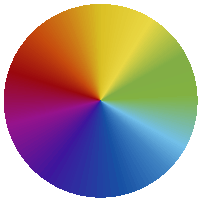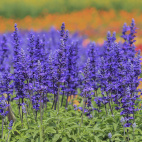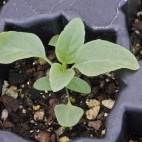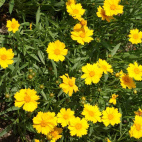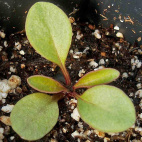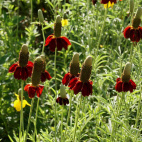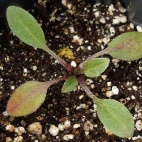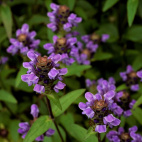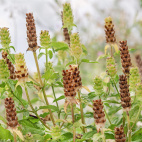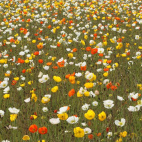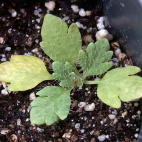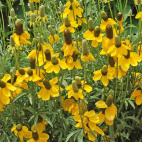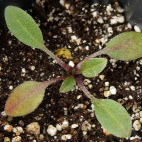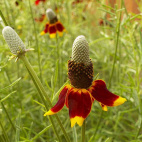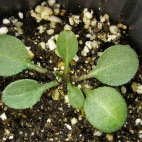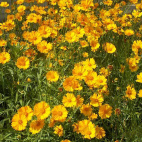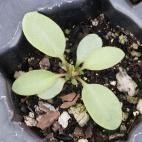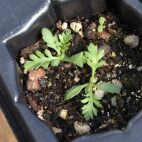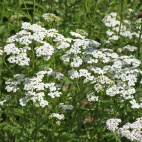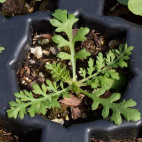Color
Availability
USDA Zone
Region
Type
Duration
Season
Germination
Soil
Sunlight
Height
Use
Narrow Your Search
Color
Availability
USDA Zone
Region
Type
Duration
Season
Germination
Soil
Sunlight
Height
Use
Wildflower Seeds - Dry West Region
The Dry West Region is one of the larger areas, but also has the fewest inhabitants. This area encompasses all of the areas in the American West that receive very little rainfall. The natural vegetation varies from true desert in the south, to sagebrush drylands in the north as well as in the higher elevations. The native species that grow in these areas are by nature very drought resistant, and able to handle the harsh conditions that are found there. The annuals that are displayed on this page need a steady source of water, so will need regular watering if they are grown. If you want to just see Western wildflower seeds for sale that will grow well without a lot of supplemental water, then filter the results by selecting "Native Wildflowers" and "Dry Soil" in the left column.
-
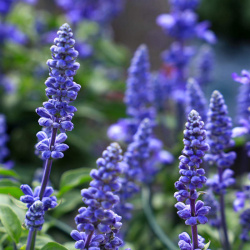 On Sale!
Blue Sage Seeds
Salvia farinacea
Dressed in vivid blue, these wildflower spikes are easy to grow. This perennial comes from Texas, so it can tolerate a lot of heat and drought. This plant has a wild habit and may look a little unruly in a refined garden.Quick View$3.48 Pkt - $15.72 / Oz
On Sale!
Blue Sage Seeds
Salvia farinacea
Dressed in vivid blue, these wildflower spikes are easy to grow. This perennial comes from Texas, so it can tolerate a lot of heat and drought. This plant has a wild habit and may look a little unruly in a refined garden.Quick View$3.48 Pkt - $15.72 / Oz -
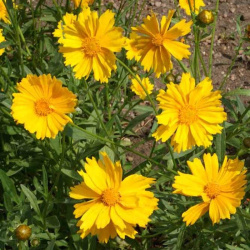 On Sale!
Dwarf Lance Leaved Coreopsis Seeds
Coreopsis lanceolata
These easy-to-grow wildflowers are a shorter member of the family that bloom late summer. A popular choice of beginning gardeners and master gardeners alike, who have limited space in their garden.Quick View$3.48 Pkt - $7.92 / Oz
On Sale!
Dwarf Lance Leaved Coreopsis Seeds
Coreopsis lanceolata
These easy-to-grow wildflowers are a shorter member of the family that bloom late summer. A popular choice of beginning gardeners and master gardeners alike, who have limited space in their garden.Quick View$3.48 Pkt - $7.92 / Oz -
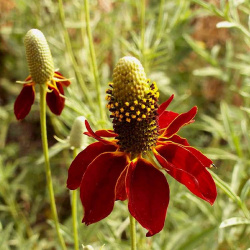 Out Of Stock
Dwarf Red Coneflower Seeds
Ratibida columnifera
This native dwarf wildflower bears a deep red flower beneath a long brown cone. This perennial does well in hot, dry areas, and is pretty easy to grow.Quick View$3.25 Pkt - $8.20 / Oz
Out Of Stock
Dwarf Red Coneflower Seeds
Ratibida columnifera
This native dwarf wildflower bears a deep red flower beneath a long brown cone. This perennial does well in hot, dry areas, and is pretty easy to grow.Quick View$3.25 Pkt - $8.20 / Oz -
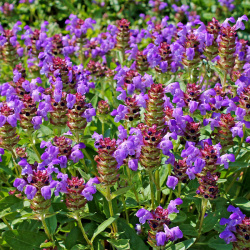 On Sale!
Heal All Seeds
Prunella vulgaris
As its name suggests, herbalists have appreciated this native plant's healing properties for centuries. It is a pretty common sight in the wild, and the bees find value in it too. The pretty purple flower does not get very tall, but it is easy to grow.Quick View$3.48 Pkt - $15.95 / Oz
On Sale!
Heal All Seeds
Prunella vulgaris
As its name suggests, herbalists have appreciated this native plant's healing properties for centuries. It is a pretty common sight in the wild, and the bees find value in it too. The pretty purple flower does not get very tall, but it is easy to grow.Quick View$3.48 Pkt - $15.95 / Oz -
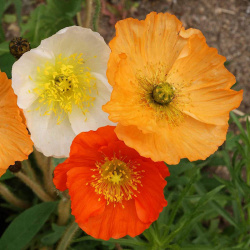 On Sale!
Iceland Poppy Seeds
Papaver nudicaule
This hardy poppy comes from the arctic regions of Canada and Europe, so makes an excellent choice for areas with harsh winters. The large blossoms often self-sow and are highly attractive to bees and butterflies.Quick View$3.48 Pkt - $13.34 / Oz
On Sale!
Iceland Poppy Seeds
Papaver nudicaule
This hardy poppy comes from the arctic regions of Canada and Europe, so makes an excellent choice for areas with harsh winters. The large blossoms often self-sow and are highly attractive to bees and butterflies.Quick View$3.48 Pkt - $13.34 / Oz -
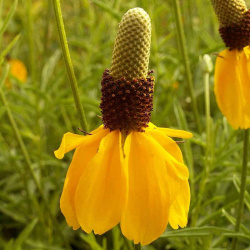 Long Headed Coneflower Seeds
Ratibida columnifera
Centered above drooping yellow petals, this prolific perennial sports dozens of tall center cones. This native is a cousin to Mexican Hat, but does not have any red streaks in it - just yellow.Quick View$2.98 Pkt - $8.93 / Oz
Long Headed Coneflower Seeds
Ratibida columnifera
Centered above drooping yellow petals, this prolific perennial sports dozens of tall center cones. This native is a cousin to Mexican Hat, but does not have any red streaks in it - just yellow.Quick View$2.98 Pkt - $8.93 / Oz -
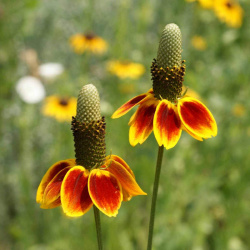 On Sale!
Mexican Hat Seeds
Ratibida columnifera pulcherrima
Aptly named, this popular Ratibida Columnifera Pulcherrima wildflower sports bright red and yellow petals beneath the tall center cone. This perennial is a native of the Great Plains, and so does well in hot, dry conditions.Quick View$2.98 Pkt - $7.92 / Oz
On Sale!
Mexican Hat Seeds
Ratibida columnifera pulcherrima
Aptly named, this popular Ratibida Columnifera Pulcherrima wildflower sports bright red and yellow petals beneath the tall center cone. This perennial is a native of the Great Plains, and so does well in hot, dry conditions.Quick View$2.98 Pkt - $7.92 / Oz -
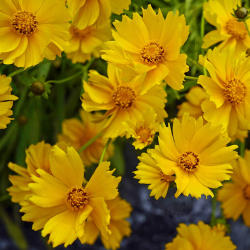 Sand Coreopsis Seeds
Coreopsis lanceolata
This golden wildflower will bring sunshine wherever it grows. A popular choice of beginning gardeners because it is so easy to grow, and produces a really satisfying flower in a short time.Quick View$2.98 Pkt - $7.52 / Oz
Sand Coreopsis Seeds
Coreopsis lanceolata
This golden wildflower will bring sunshine wherever it grows. A popular choice of beginning gardeners because it is so easy to grow, and produces a really satisfying flower in a short time.Quick View$2.98 Pkt - $7.52 / Oz -
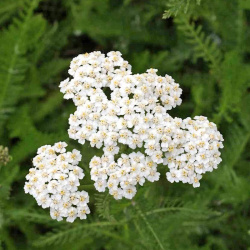 Western Yarrow Seeds
Achillea millefolium occidentalis
Growing clusters of small white flowers and feathery foliage, this is one of the most common wildflowers in the western United States. Yarrow makes an excellent pollen source in arid conditions.Quick View$2.98 Pkt - $9.54 / Oz
Western Yarrow Seeds
Achillea millefolium occidentalis
Growing clusters of small white flowers and feathery foliage, this is one of the most common wildflowers in the western United States. Yarrow makes an excellent pollen source in arid conditions.Quick View$2.98 Pkt - $9.54 / Oz -
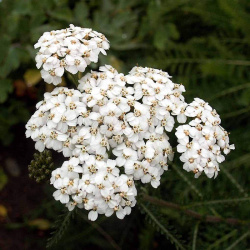 On Sale!
White Yarrow Seeds
Achillea millefolium
This wildflower is a common sight across the US and is often found growing in dry soils. The foliage is aromatic, and the long-lasting flowers work well for dried arrangements. Yarrow is also a valuable species for its herbal properties.Quick View$2.98 Pkt - $8.20 / Oz
On Sale!
White Yarrow Seeds
Achillea millefolium
This wildflower is a common sight across the US and is often found growing in dry soils. The foliage is aromatic, and the long-lasting flowers work well for dried arrangements. Yarrow is also a valuable species for its herbal properties.Quick View$2.98 Pkt - $8.20 / Oz
The Dry West Region is one of the larger areas, but also has the fewest inhabitants. This area encompasses all of the areas in the American West that receive very little rainfall. The natural vegetation varies from true desert in the south, to sagebrush drylands in the north as well as in the higher elevations. The native species that grow in these areas are by nature very drought resistant, and able to handle the harsh conditions that are found there. The annuals that are displayed on this page need a steady source of water, so will need regular watering if they are grown. If you want to just see Western wildflower seeds for sale that will grow well without a lot of supplemental water, then filter the results by selecting "Native Wildflowers" and "Dry Soil" in the left column.

